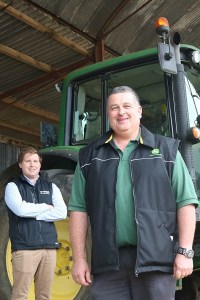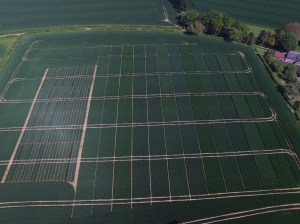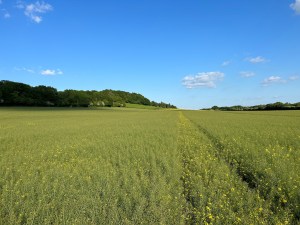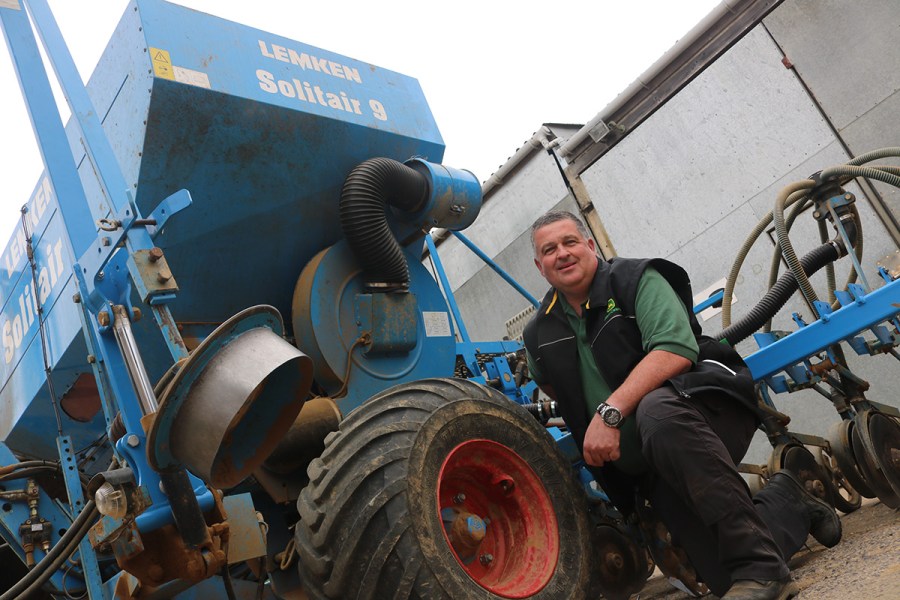Reducing risk of crop failure is key with oilseed rape, and even more so when the crop is a vital part of the farm’s rotational strategy.
“We haven’t had any cabbage stem flea beetles or rape winter stem weevil at all this season.”
By Mike Abram
Break crops are an essential part of every rotation and oilseed rape is a core part of Somerset grower Mark Doble’s plan to move to 50% first wheat and 50% break crop.
Hurcott Farm, a 160ha tenant farm near Ilminster, lies between Taunton and Yeovil in south Somerset, and is currently growing winter wheat for seed, OSR, winter linseed, maize and a small area of potatoes.
“Previously we were on a five-year rotation, which included winter barley in front of potatoes and OSR, but my wife and I became fed up pulling volunteer barley out of the following wheat crops. So we decided to drop the winter barley to ease that problem,” he explains.
For many growers, the early harvesting of winter barley has made it a valuable entry crop into OSR, allowing early drilling in an attempt to get the crop established before adult cabbage stem flea beetle attacks. Mark has gone to the other extreme and drilled this year’s OSR crop in mid-September.
Part of his explanation for this is that, while adult flea beetle damage has largely been avoided in the past, larval infestations in the spring has taken out crops. “That was especially the case in harvest 2020 – we had a good crop until February/March and then it started to disappear in front of our eyes.”
With that in mind, in conjunction with his agronomist Steven Mears of Crop Management Partners and BASF local agronomy manager Richard Guest, he has tried pushing drilling date back into September in the past two seasons, following a one-year break from the crop by design.
“ADAS data shows that later delayed drilling positively correlates with lower larval burden,” explains Richard. “Later drilling is a good option in the milder South West and since Mark pays close attention to detail, with good seed to soil contact, he achieves quick emergence and good early growth.”
In autumn 2021, the OSR was drilled around 6 September, and while there was still some cabbage stem flea beetle in the field, the crop survived and performed well enough for Mark to double-down and drill on 17 September this autumn.
He uses a combination drill to establish his 27ha of OSR, which is split between two Clearfield varieties, BASF’s InV1266CL and Matrix CL from DSV.
The farm has two distinct soil types – 100% sand and a sandy clay brash. Both make minimal cultivations difficult, says Mark. “We need to get air back into the ground because it slumps and is very erosion prone, so we lift the soil either by plough or subsoiler.”
Two of the four fields this season have significant charlock weed burdens and Mark is keen to keep management straightforward across the entire area, which is why he has opted for 100% Clearfield across the farm.
“The other benefit is that the herbicide in the Clearfield system, Cleravo (imazamox+ quinmerac), is probably the most broad-spectrum herbicide for OSR,” points out Richard. “Being post-emergence, it allows us time in the autumn to weigh up whether we have a crop or not before deciding whether to spend on it.”
The farm trialled several different BASF Clearfield varieties versus a couple from competitors last season, but Mark is satisfied with the yields he’s achieving and saw no reason to change.

Oilseed rape is a key part Mark Doble’s (foreground) plan to move to 50% first wheat and 50% break crop and, with support from BASF’s Richard Guest, use of Clearfield hybrids allows him to drill later.
InV1266CL has very fast autumn growth making it suitable for late drilling and, according to BASF, it excels in challenging conditions and has proven to be a consistent variety. Matrix CL is the top yielding Clearfield variety on the AHDB Recommended List at 99% of the controls in the East/West region.
“Clearfield varieties have improved considerably over the past few years,” notes Richard. He points out that yields now are up with the mainstream so there is no compromise to having them as your choice of hybrid.
As well as comparing different varieties, BASF’s trial on the farm also looked at some cultural controls for cabbage stem flea beetle across each variety strip, including the spreading of digestate, companion cropping and the use of a nematode for biological control of adult cabbage stem flea beetles.
A PhD project at Harper Adams University College, led by Claire Hoarau, screened four species of nematodes and found some promising activity against cabbage stem flea beetle adults in laboratory studies. But it’s still early days in development, explains Richard.
Mark has, however, drilled a companion crop of buckwheat and fenugreek with his OSR and spread digestate on the land this season, even though results, including larval counts, were similarly inconclusive due to low pest numbers.
“We haven’t had any cabbage stem flea beetle or rape winter stem weevil at all this season, although we did have to apply a round of slug pellets.”
After a mid-October spray to take out some volunteer cereals, the Clearfield herbicide Cleravo was applied in good growing conditions in early November (according to the ‘When2go’ app for quinmerac water stewardship) in conjunction with an autumn fungicide.

The farm has trialled different Clearfield varieties and a whole range of cultural controls for CSFB.
Once established, his philosophy – which also applies to other crops in the rotation – is to push for yield as much as possible. His target for OSR is 4.3t/ha, while for first wheat he’s aiming for a minimum of 10t/ha.
“We seem to be able to maintain high yields here with a little and often approach to feeding the crop, based on leaf testing. Having done a lot of trials work with wheat, in particular, over the past 30 years, we found the more you put in, the more you get out, whether it’s feeding the crop or protecting it.”
He used a micronutrient blend in the form of Yara’s Brassitrel Pro to supply manganese, magnesium, boron and molybdenum in the spring, while Architect (pyraclostrobin+ mepiquat+ prohexadione) was applied in both autumn and spring to provide phoma and light leaf spot control plus growth regulation. Prothioconazole was used as a flowering spray.
Growth regulation is important on Mark’s farm, says Richard. “It’s relatively fertile ground, and with digestate in the autumn it has a good level of residual nutrition under the crop. Growth regulators will also help manipulate the canopy – reducing apical dominance to increase branching.”

As well as controlling brassica weeds, the herbicide used in the Clearfield system has a broad spectrum of control.
Mark is also used to cutting shorter crops – he previously grew semi-dwarf varieties – and aims to cut them as low as possible to maximise straw, which he sells to a local contractor to bale and use for his turkeys.
“It adds to whatever the rapeseed price is at the time and removes some of the slug burden that can happen if you have too much rape straw going back onto the field.”
Marketing of the crop is through a United Oilseeds harvest pool. “It’s an area-produced contract so there’s no set tonnage. We sign up in October or November, when we know we have a crop, and United Oilseeds do the marketing and pick the rapeseed up within five days of harvesting. A month later we get an interim or base price and then in December they pay the balance.
“Last year the interim payment was £500/t, but I don’t hold out much hope we’re going to achieve that again,” he says ruefully. “Things have changed a lot from when we drilled the crop.”
While he could have sold forward on a contract at drilling, he says it’s a brave person who sells OSR when, at that point, it’s a crop they don’t technically have.
“With the area-produced contract it takes out that risk, as long as you’ve got a crop established. That ties in with growing Clearfield because you’re not having to spend anything until after you’ve drilled the crop and can see you have one,” he concludes.
OSR outlook mixed

Cleravo can be applied from the cotyledon stage which gives a wider window of weed control in the Clearfield system, says Clare Tucker.
If growers could choose a break crop to grow before taking into account risk of failure, OSR would likely be at the top of many lists.
“It’s still usually the most profitable break crop,” notes BASF’s business development manager Clare Tucker, although prices in May for wheat and OSR were heading below the 2:1 ratio, where growing OSR in preference to a cereal becomes attractive.
But there are many positive benefits to growing the crop, such as: spreading workloads during harvest and autumn drilling, providing access to alternative grassweed chemistry from that used in cereals, and mopping up nitrogen in the autumn, reducing leaching and potentially lowering N requirements in the spring, she points out.
The risks, however, remain with cabbage stem flea beetle and, for some, a new nemesis in rape winter stem weevil emerged this season.
“We think the hard frosts over winter and into early spring may have exacerbated damage from these pests. The larvae of both feed in the main stems, making them much more vulnerable to frosts breaking them open.”
Growers have developed tactics to combat flea beetle reasonably effectively; extending rotations, companion cropping, use of digestate and changing drilling dates – either earlier or later – to try to avoid damage.
“I think we’re getting a handle on how to combat adults in the autumn,” suggests Clare. “The overriding factor, which was very obvious last autumn, is having enough moisture for even establishment and for the crop to emerge in about five days. The key is to have flexibility in drilling date – it’s the conditions that matter.”
Good establishment, with early vigour and good autumn growth, will produce strong individual plants by spring that can tolerate larval infestations better, as well as pigeons.
Where growers are confident of establishing the crop before the main beetle influx, pre-emergence herbicides can play a useful role in helping to remove weed competition earlier and giving more flexibility around post-em options, says Clare.
“You can delay or not require a post-em application of Belkar (arylex + picloram) because the pre-em has suppressed or controlled weeds and has also given a contribution to grassweed control. The herbicide actives dimethenamid-P and metazachlor can take out up to 70% of grassweeds, leaving less work for clethodim and propyzamide.”
Large populations of grassweeds tend to compete with each other and grow quickly, making it difficult to get the timing right for clethodim, she adds. “If you have fewer plants emerging, they grow more slowly and stay at the optimum timing for control of two-leaf for longer.”
An alternative strategy is to use the Clearfield system. In this, Cleravo can be applied from the cotyledon stage, whereas non-Clearfield post-em herbicide Belkar can only be used from two true leaves and must be applied after 1 September.
“It means you have timely removal of weeds from one to four true leaves,” says Clare.
Brassica species are a key strength of the Clearfield system, but it also controls a wide range of weeds, she points out. “Another reason why growers are interested in Clearfield is the varieties are unaffected by ALS herbicide residues.
“We have to accept that growers are not always following the label advice for ALS products, like Atlantis (mesosulfuron+ iodosulfuron), for ploughing before OSR because they’re trying to maintain moisture, which means the herbicide residues aren’t breaking down.”
Later applications of ALS inhibitors and dry seasons exacerbate the issue. “You are relying on warmth and moisture to break down the residue,” she explains.
“The ALS residue doesn’t take a crop out, unless it’s really bad, but it slows down crop emergence. Growers who used Clearfield have been pleasantly surprised the crop comes through so quickly, and we’ve seen that in comparisons.”
Real Results Live Demo Days 2023
 BASF’s Real Results Live Demo days are back for 2023, taking place across six sites throughout the UK this summer, including Hurcott Farm.
BASF’s Real Results Live Demo days are back for 2023, taking place across six sites throughout the UK this summer, including Hurcott Farm.
Key highlights:
- Industry Expert-led tour of 20 winter wheat varieties
- Revystar XE in action against different varietal genetics and disease situations
- Speak to a dedicated Herbicide expert at the Luximo weed hub to find out more about the new mode of action, including trials data and the latest IPM advice
- Learn about Limus, an innovative, dual-active urease inhibitor for urea and UAN
- Live demonstration of the easyconnect closed-transfer system
- BASIS and NRoSO points
Events:
15 June – Bourne
D.S. & J.E King & Son, Pasture Hill Farm, Edenham Road, Bourne, Lincolnshire, PE10 0LG
27 June – Hurcott
Hurcott Farm, Hurcott, Ilminster, Somerset, TA19 0JS
28 June – Stonham
RH Forrest, Mowness Hall, Stonham Aspal, IP14 5JJ
30 June – Great Tew
Westfield Lodge, Great Tew, Chipping Norton, OX7 4BT
5 July – Rawcliffe Bridge
Top House Farm, Moor Road, Rawcliffe Bridge, DN14 8PU 
6 July – Pencombe
J & D Thomas, Stewarts Hyde, Pencombe, Herefordshire, HR7 4SQ
Register online.
This article was taken from the latest issue of CPM. For more articles like this, subscribe here.
Sign up for Crop Production Magazine’s FREE e-newsletter here.




